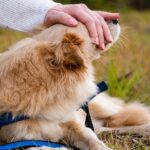Similar to neuter surgeries, spaying is one of the most performed routine surgeries in a vet clinic. However, it’s not always easy for pet owners to know what their dog will look like after this procedure.
The incisions are usually very small and hidden under the skin. They can be seen only when the dog has been shaved or had its hair removed.
In most cases, the incision wounds will heal without any signs of surgery later. But how do you know that your dog’s incision wound looks normal?
In this article, we take a look at what a normal dog spay incision looks like, and what pet owners can do to prevent infections.

What To Expect After Your Dog’s Spaying Surgery
In the first 12 hours after your dog’s spaying operation, you’ll notice that your pet is not able to stand up. She will be tired and lethargic.
This is normal. It takes a few days for her body to recover from surgery. During this time she may experience some discomfort. Your vet should give you take-home medication and antibiotics to give to your dog.
You need to ensure that she is urinating regularly, and it’s a good idea to stay nearby, so you can check she is okay.
Your dog will have a pet cone on to prevent her from licking the wound. But sometimes dogs open the collar and end up opening the wound by licking or biting it.
As your dog is still fatigued from the surgery, you will notice that she doesn’t want to drink or eat as much as normal. This should improve within the first 24-48 hours after surgery, and then her appetite should be back to normal.
How Do You Know Your Dog’s Incision Is Healing?
It can be difficult to tell if your dog’s spaying incision wound is healing, but there are some things that will help you determine how well the surgery went and whether or not your dog needs any additional care.
The veterinarian who performed your dog’s surgery should be able to tell you what to look for when checking on your dog’s incision.
It’s important to remember that every dog is different, and therefore each dog’s wound will heal differently. Here are some of the signs that your dog’s wound is healing correctly.
Reduced Swelling And Bruising
In the first 48 hours, the incision wound will still look swollen and bruised. This should subside within around a week.
Reduced Redness
The spaying incision may look red or pinkish at first, but you should notice after a week that the redness is all gone.
No To Little Discharge
Right after your dog’s surgery, you might notice a small amount of discharge coming out of the incision site.
However, this should stop within a few days after surgery. If it continues, pet owners should contact their vet immediately.
Reduced Soreness Around The Wound
Your dog will feel soreness at the incision site. However, this should go away within a day or two. You should not touch the incision wound and make sure that your dog is allowed to rest as much as possible during the healing process.
How Long Does It Take For A Spay Incision To Heal?
Most spay incisions will heal properly in about 10-14 days. The exact time of your dog’s recovery period will depend on your dog’s overall health and how the vet sealed the wound.
Some vets use external sutures to close the wound, while others seal the incision with internal stitches. Both are absolutely safe as part of the spay procedure.
Signs Of Infection
If your dog has an infection at the incision site, it could delay the healing process and it can cause further serious health implications for your pet.
There are many reasons why your dog could get an infection. Some common causes include:
- Poor hygiene
- Overuse of antibiotics
- Not cleaning wounds properly
- Licking or chewing at the incision site
- A loose or open stitch
However, sometimes even with the greatest care, an incision wound of a spayed bitch can get infected.
Here are some of the main signs of infection.
Swelling
Your dog will have swelling at the incision site and around the area where the stitches were placed. This should disappear in the first few days.
If you notice swelling around the surgical incision, together with some of the other symptoms, check with your vet.
Heat
Combined with the swelling, an infected wound will also radiate heat, which you can feel when you gently hover your hand above the wound.
The heat should disappear after around two days after surgery.
Bad Odor
An infected wound will often smell bad and have a foul odor. This bad odor can smell rotten or sterile.
This comes from bacteria building in and around the wound. A healthy wound doesn’t have a smell, so if you can smell any new odor coming from your dog’s incision wound, then call your veterinarian.
Discharge
Although there may be small amounts of discharge in the first couple of days, continual discharge from the wound indicates that there may be an infection.
The initial discharge is likely to be light pink. In comparison, the discharge of an infection will look either dark red, yellow, or green.
Red Color
At first, the spay incision wound of your dog will look bright red, but it should gradually go down to a lighter pink, and then the reddish hue should disappear.
If your dog’s wound goes to light pink and then turns red again, it may be due to chafing or the dog licking the wound. Try to ensure that the wound stays clean and the dog doesn’t lick it until it’s fully healed.
If you notice the redness with any other symptoms, such as swelling and discharge, it’s likely an infection that should be checked by your vet.
Other Signs Your Dog’s Wound Is Infected
A dog with an infected incision wound may also appear lethargic, in pain, or display other symptoms such as fever or diarrhea. Your dog may feel restless and uncomfortable, even with the pain medication.
If this is the case, the infection may have spread to other parts of the dog’s body, and it’s important to contact your vet immediately.
As a rule of thumb, if you notice any changes with your dog’s incision, such as increased swelling, bleeding, fever, pain, or unusual behavior, you should seek veterinary attention right away.
How To Care For Your Dog’s Spaying Incision
There are a few steps you can take to avoid nasty infections of the spay incision and to ensure your dog’s smooth recovery.
Don’t Touch The Wound
You shouldn’t touch your dog’s incision for several weeks. No matter how well we clean our hands, bacteria can sit everywhere, and touching the wound may introduce bacteria to this vulnerable area.
Touching may also irritate the skin around the wound, which could lead to redness and increased soreness.
Regularly Check For Infections
It’s important to regularly check your dog’s spaying incision for signs of infection. Check the wound every day for any signs of redness, swelling, or pus.
Also, make sure to observe your dog’s activity levels. Is she eating and drinking again? Is she getting more active every day?
Your dog’s energy level should increase gradually, and any sign of tiredness should have gone within a couple of weeks.
Ensure The Dog Doesn’t Lick The Wound
Licking at the wound may cause irritation and damage to the tissue surrounding the incision. It may also create a breeding ground for bacteria, which can result in an infection.
To prevent your dog from licking her incision, she should wear a dog cone.
No Swimming Or Bathing
Most dogs love water, and it can be difficult to keep them from swimming. However, bathing your dog too soon could cause the wound to get infected.
It’s best not to bathe your dog before they’ve had time to heal completely. It’s possible that the bathwater could irritate the wound further, causing more discomfort.
You should avoid swimming or bathing your dog for a minimum of one month.
Will The Incision Stitches Dissolve?
Yes, the stitches used during spaying will dissolve over time. Most vets use internal and external sutures that simply dissolve over time.
This will save you the trouble of going back to the vet for removing the stitches. It also means that your dog is not stressed with further treatment.
However, some dogs may experience complications after their surgery due to the presence of stitches. In these cases, it’s recommended that the veterinarian removes the stitches once the wound has healed.
Final Thoughts
Spaying is a safe procedure for most dogs. If done by a qualified professional, it’s a simple outpatient procedure that takes only a few minutes.
The main risk associated with spaying is the possibility of developing an infection. This is why it’s so important to follow all of the post-surgical instructions given by your veterinarian.
If you’re considering spaying your dog, talk to your vet about what to expect and ask questions.
- What Dog Breeds Have Pink Skin? - March 24, 2023
- What Are the Most Inspiring Dog Breeding Quotes? - March 20, 2023
- Can Pheromone Spray Help Improve Dog Breeding Results? - March 19, 2023








